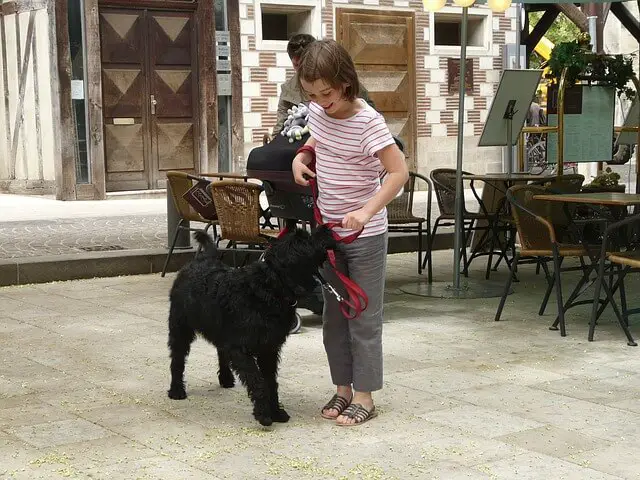Why Does My Dog Herd Kids and Adults? Here’s How to Solve It
30.03.2022.
Getting a herding breed means you have an intelligent, active, and hardworking dog. However, don't be surprised if the dog comes with some other characteristics included. Herding breeds were specifically developed to work around livestock such as goats, sheeps or cattle, just as their name implies.
Because of their common ancestors, herding breeds have the instinctive ability and drive to manipulate and guide the other animals' movements. However, to dogs of these breeds, "other animals" sometimes include the humans they live with. Here’s what you should know about why dogs herd kids and adults.
Activating the predatory sequence
Dogs have been used for transporting animals from one area to the next for several thousands of years. If you've ever seen a working dog herding livestock, you'll understand how deeply rooted and impressive their abilities are. These abilities are not taught to the dog. Instead, they rather emerge instinctively.

Dogs’ ancestors were predators, so they still retain a specific set of behaviors necessary for catching prey. The complete set of actions is as follows:
- Lookup
- Stalk
- Chase
- Grab
- Kill
- Dissect
- Consume
Based on the original purpose of a breed, some or all of the instinctive predatory behaviors may survive. Terriers, for example, were developed to hunt animals such as foxes, rats, coyotes, and badgers that posed a threat to livestock. Because of their original purpose, herding dogs can still harbor pretty keen predatory instincts.
At the same time, Toy dogs took a different path, and humans developed them exclusively as companions. It is only natural you'd expect most of them to have predatory instincts "bred out" of them. However, as the Toy dog industry has demonstrated, almost every dog contains predatory instincts. However, those instincts usually come out when toy dog owners play with their dogs with various toys at home.
Herding breeds were carefully bred to make the early stages of their predatory behavior and instincts more prominent than the later stages. In particular, the first three stages - locating, stalking, and chasing. The latter predatory parts of behavior have been significantly controlled with years of selective breeding. Keep in mind that these traits vary from one herding breed to the next.

The Border Collie, for example, is well-known for its ability to "eye" or stare down livestock in order to manipulate their movement. They may nip a particularly stubborn sheep or cattle now and then, but nipping is not typically part of their MO. Their predatory behavior usually ends with a chase. One of the best herding breeds in the world is the Australian Cattle Dog. They are also known as Blue Heelers. These dogs herd by nipping the feet of cattle. The predatory behavior for Heelers ends with a grab and bite sequence.
How to prevent herding problems
Even though herding is very useful for dogs who must move livestock, the instinct can also be activated inside the home. Dogs will instinctively herd anything available. Often, that includes other pets, children, and even you. Because these rooted instincts are typically triggered by various movements, your dog is unlikely to herd just for attention or because they're intentionally misbehaving.
Dogs aren't confused about whether children are sheep or not. And it's unlikely that your pant legs resemble cow hooves. When movement grabs their focus, dogs are simply following their natural instincts. Of course, not moving when your dog is around will not solve the problem. However, keep an eye out for problem reactions. Imagine this - if your children runningly move from the dog when it tries nipping their feet, the behavior will be reinforced.
Training
While teaching basic obedience, try to keep your dog from engaging in herding behaviors as much and as often as possible. When there are moving objects nearby, teaching your dog commands like "Watch Me" and "Leave It" can redirect your herding dog's attention away from the object and their instincts.

It's also a good idea to teach your dog impulse control. Fetch and tug-of-war, for example, are excellent games that will entertain your herding dog. However, before throwing the ball or giving them the tug toy, tell your dog to perform a calm behavior such as lying down, rolling, or sitting. This reinforces proper etiquette and shows your dog they need to keep calm and ignore their herding and predatory instincts.
Giving your dog's body and mind a good workout is also important. Herding breeds were bred to work hard for long periods in tough conditions. They are extremely intelligent and will entertain themselves if you do not provide them with something to do. Check to see if you're giving your dog enough physical activity. Finally, think about games that will test your dog's brain, such as hide and seek, learning new commands, or other problem-solving activities.
Changing your dog's herding instincts
It is not really realistic to expect your herding dog to completely shut off their herding instincts. Instead, think about finding a suitable outlet for controlling those urges. The dog sport of herding is the most obvious outlet. If that isn't an option, you should consider Treibball. Treibball is characterized by the "herding" of large plastic balls around a predefined field or arena. This could be a particularly appealing option for herding dogs that live in cities.
Other dog sports will help your dog meet their herding needs. The sport of Flyball is ideal for dogs who are obsessed with playing fetch and chasing tennis balls. This relay race-style sport demands dogs to channel their instincts by running over various hurdles until they reach a spring-loaded pad that releases a tennis ball. The dog has to catch it before returning it to its handler. Another excellent option for herding dogs that love playing fetch is Disc dog, which is played with a flying disc. Finally, agility is fantastic for engaging your dog's body and brain, providing strenuous exercise, and building teamwork. Agility will require you to direct your dog through an obstacle course consisting of tunnels, jumps, and weave poles.
World Dog Finder team







Share